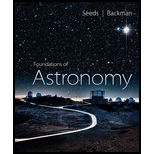
Why would you include the Moon in a comparison of the Terrestrial planets?
The reason why moon is included in comparison of the terrestrial planets.
Answer to Problem 1RQ
The moon is included in comparison of the terrestrial planets because moon has all the characteristics of the terrestrial planets in it.
Explanation of Solution
Terrestrial planets are those planets whose surfaces are made up of rocks and metals. Mercury, Venus, Earth and Mars are among them.
Moon is located in the Earth of the solar system with other terrestrial planets. Moon is revolving around the sun like a planet is moving around the Solar system.
As moon is not the planet, it is a natural satellite, however, it is considered to be a planet due to its properties which is similar to the planet.
Therefore, the moon is included in comparison of the terrestrial planets due to its characteristics of the terrestrial planet.
Want to see more full solutions like this?
Chapter 19 Solutions
Foundations of Astronomy (MindTap Course List)
- Mick and Rick are twins born on Earth in the year 2175. Rick grows up to be an Earth-bound robotics technician while Mick becomes an intergalactic astronaut. Mick leaves the Earth on his first space mission in the year 2200 and travels, according to his clock, for 10 years at a speed of 0.75c. Unfortunately, at this point in his journey, the structure of his ship undergoes mechanical breakdown and the ship explodes. How old is Rick when his brother dies?arrow_forwardHi, I have canceled, why did you charge me again?arrow_forwardNo chatgpt pls will upvotearrow_forward
 Foundations of Astronomy (MindTap Course List)PhysicsISBN:9781337399920Author:Michael A. Seeds, Dana BackmanPublisher:Cengage Learning
Foundations of Astronomy (MindTap Course List)PhysicsISBN:9781337399920Author:Michael A. Seeds, Dana BackmanPublisher:Cengage Learning
 An Introduction to Physical SciencePhysicsISBN:9781305079137Author:James Shipman, Jerry D. Wilson, Charles A. Higgins, Omar TorresPublisher:Cengage Learning
An Introduction to Physical SciencePhysicsISBN:9781305079137Author:James Shipman, Jerry D. Wilson, Charles A. Higgins, Omar TorresPublisher:Cengage Learning AstronomyPhysicsISBN:9781938168284Author:Andrew Fraknoi; David Morrison; Sidney C. WolffPublisher:OpenStax
AstronomyPhysicsISBN:9781938168284Author:Andrew Fraknoi; David Morrison; Sidney C. WolffPublisher:OpenStax
 Horizons: Exploring the Universe (MindTap Course ...PhysicsISBN:9781305960961Author:Michael A. Seeds, Dana BackmanPublisher:Cengage Learning
Horizons: Exploring the Universe (MindTap Course ...PhysicsISBN:9781305960961Author:Michael A. Seeds, Dana BackmanPublisher:Cengage Learning





